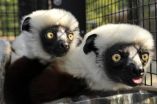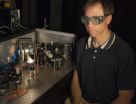(Press-News.org) As winged dinosaurs underwent a series of evolutionary changes during the transition into Aves, or birds, one pivotal transformation was the appearance of a single-ovary reproductive system. "The most widely accepted hypothesis for the presence of a single functional ovary in living birds is that the right ovary … was lost to reduce body mass in gravid females during flight," report a team of Chinese scientists who are adding new details to the mosaic of understanding how terrestrial dinosaurs gave rise to birds and powered flight.
These scientists, led by the director of the prestigious Institute of Vertebrate Paleontology and Paleoanthropology in Beijing, posit that this adaptation of the reproductive system likely occurred "gradually during the evolution of dinosaurs and basal birds," yet add that until recently, the fossil record provided only scattered evidence on the timeline of these phylogenetic changes.
But the discovery of a series of fossils that include evidence of single ovaries in the basal bird Jeholornis and in an array of more derived enantiornithine birds from the Cretaceous, in what is now eastern China, is helping them pinpoint the timing of the pared-down reproductive system of avian dinosaurs.
Members of Aves, which includes the common ancestor of the 150 million-year-old Archaeopteryx and all living birds, are unique among amniotes in terms of featuring a single-ovary system, notes Zhonghe Zhou, director of the IVPP and lead author of the study "Ovarian follicles shed new light on dinosaur reproduction during the transition towards birds."
One feathered dinosaur considered closely related to birds, the oviraptorosaurian maniraptoran theropod, had two functional ovaries, according to Zhou and co-authors of the paper.
In contrast, they add, the fossil of the primitive bird Jeholornis that was recently uncovered in the northeastern Chinese province of Liaoning featured the lighter-weight single ovary system. "Jeholornis," they explain, "with its long dinosaurian boney tail, is only slightly more derived than Archaeopteryx, indicating that even the most basal birds were already modern in this aspect."
This provides evidence that the evolution in the reproductive structure "occurred at — or very near — the dinosaur–avian transition, supporting the hypothesis that birds lost the use of [one] ovary due to the energetic pressures of flight," Zhou and colleagues state.
Zhonghe Zhou and IVPP scholar Jingmai K. O'Connor, along with Xiaoting Zheng, Xiaoli Wang, and Yan Wang of the Institute of Geology and Paleontology at Linyi University, in the eastern Chinese province of Shandong, presented their findings in a study published by the just-launched journal National Science Review.
The National Science Review is the first comprehensive scholarly journal published in English in China that is aimed at linking the country's rapidly advancing community of scientists with the global frontiers of science and technology. The journal also aims to shine a worldwide spotlight on scientific research advances across China.
Zhonghe Zhou and the Institute of Vertebrate Paleontology and Paleoanthropology, which is part of the Chinese Academy of Sciences, have long been at the forefront of characterizing the remarkable winged dinosaurs that are being uncovered across China.
Following the discovery of microscopic evidence of feather coloring and patterns in dinosaur and bird fossils dating back to the late Jurassic, the IVPP set out to begin depicting these species in living color. The finding of melanosomes, or pigment-bearing organelles, embedded in the fossil feathers of select dinosaur specimens unexpectedly provided a means to reconstruct a wide array of feathered dinosaurs with a scientifically precise palette, Zhou said in an earlier interview with EurekAlert!.
The examination of a sampling of dinosaur fossils from the Early Cretaceous Jehol Biota and the Jurassic Yanliao Biota (dating back about 160 million years) using a scanning electron microscope uncovered the color-triggering melanosomes. The discovery, Zhou said, could enable the reconstruction across a full-color spectrum of dinosaurs featuring pennaceous feathers resembling the flight feathers of modern birds. Studies have already involved Sinosauropteryx, the dromaeosaurid Microraptor gui and the Jurassic Anchiornis. They could also extend to more dinosaurs and other vertebrates such as mammals, pterosaurs, and lizards.
In the new study published in the National Science Review, the Chinese scientists also report that the number of ovary follicles discovered in Aves specimens tended to decrease over the course of evolution, with Jeholornis featuring 20 eggs and some fossils of enantiornithine birds, which became extinct, along with non-avian dinosaurs, at the end of the Cretaceous 66 million years ago, carrying only 5-6 follicles.
This decrease likely reflects "a broad trend toward more K-selected life history strategies," they posit in the paper. "This trend toward more K-selected lifestyles continues into Neornithes, in parallel to the Cretaceous radiation of enantiornithines," they explain.
Zhonghe Zhou says the new paper chronicles progress made following a previous report in Nature, while adding some new specimens. "It is also notable," he says, "that we are looking for more fossil evidence of follicles in birds and hopefully more information will be revealed in the future."
INFORMATION:
See the article:
Jingmai K. O'Connor, Xiaoting Zheng, Xiaoli Wang, Yan Wang, and Zhonghe Zhou. Ovarian follicles shed new light on dinosaur reproduction during the transition towards birds. Natl Sci Rev (March 2014) 1 (1): 15-17
http://nsr.oxfordjournals.org/content/1/1/15.extract
By Kevin Holden
Chinese scientists map reproductive system's evolution as dinosaurs gave rise to birds
2014-05-30
ELSE PRESS RELEASES FROM THIS DATE:
Observing the random diffusion of missing atoms in graphene
2014-05-30
This news release is available in German. Imperfections in the regular atomic arrangements in crystals determine many of the properties of a material, and their diffusion is behind many microstructural changes in solids. However, imaging non-repeating atomic arrangements is difficult in conventional materials. Now, researchers at the University of Vienna have directly imaged the diffusion of a butterfly-shaped atomic defect in graphene, the recently discovered two-dimensional wonder material, over long image sequences. The results are published in the prestigious journal ...
Genome sequences show how lemurs fight infection
2014-05-30
DURHAM, N.C. -- The young lemur named Eugenius started to get sick. Very sick. He was lethargic, losing weight and suffering from diarrhea. Duke Lemur Center veterinarians soon pinpointed the cause of his illness: Eugenius tested positive for Cryptosporidium, a microscopic intestinal parasite known to affect people, pets, livestock and wildlife worldwide.
In humans, thousands of cases of Cryptosporidium are reported in the United States each year, spread primarily through contaminated water.
Since Eugenius was the first animal diagnosed in 1999, the parasite has caused ...
New printable robots could self-assemble when heated
2014-05-30
Printable robots — those that can be assembled from parts produced by 3-D printers — have long been a topic of research in the lab of Daniela Rus, the Andrew and Erna Viterbi Professor of Electrical Engineering and Computer Science at MIT.
At this year's IEEE International Conference on Robotics and Automation, Rus' group and its collaborators introduce a new wrinkle on the idea: bakable robots.
In two new papers, the researchers demonstrate the promise of printable robotic components that, when heated, automatically fold into prescribed three-dimensional configurations. ...
Radiation for prostate cancer linked to secondary cancers, study finds
2014-05-30
ANN ARBOR, Mich. — Among men treated for prostate cancer, those who received radiation therapy were more likely to develop bladder or rectal cancer, according to a new study from the University of Michigan Comprehensive Cancer Center.
"Overall the incidence of these cancers is low. But when men have received radiation treatments, it's important to evaluate carefully any symptoms that could be a sign of bladder or rectal cancer," says senior study author Kathleen A. Cooney, M.D., professor of hematology/oncology and urology at the U-M Medical School.
The study, which ...
Novel NIST laser system mimics sunlight to test solar cell efficiency
2014-05-30
Researchers at the National Institute of Standards and Technology (NIST) have developed a laser-based instrument that generates artificial sunlight to help test solar cell properties and find ways to boost their efficiency.
The novel NIST system simulates sunlight well across a broad spectrum of visible to infrared light. More flexible than conventional solar simulators such as xenon arc-lamps or light-emitting diodes, the laser instrument can be focused down to a small beam spot—with resolution approaching the theoretical limit—and shaped to match any desired spectral ...
Rush a light wave and you'll break its data, say NIST scientists
2014-05-30
Quantum information can't break the cosmic speed limit, according to researchers* from the National Institute of Standards and Technology (NIST) and the University of Maryland's Joint Quantum Institute. The scientists have shown how attempts to "push" part of a light beam past the speed of light results in the loss of the quantum data the light carries. The results could clarify how noise might limit the transfer of information in quantum computers.
The speed of light in vacuum is often thought to be the ultimate speed limit, something Einstein showed to be an unbreakable ...
Study suggests strong link between depression and early death among seniors with diabetes
2014-05-30
People with diabetes have about double the risk of premature death as people of the same age without diabetes. Studies also have shown that they have about twice the odds of suffering from depression, which further increases their mortality risk.
A new UCLA-led study published in the Journal of the American Geriatrics Society found that among adults 65 and older with diabetes, depression is linked with a far greater chance for early death compared with people of the same age who do not have depression.
The researchers suggest that the higher mortality rate among those ...
Hero or sissy? Study explores perception of injured athletes
2014-05-30
NFL teams shoulder most of the blame for players' injuries and sports journalists can shift football cultural norms toward valuing players who put their health first.
These are the key findings of a new study authored by Clemson University researchers Jimmy Sanderson and Melinda Weathers that examined health and safety issues in sports. It was published in the journal Communication & Sport.
"Media coverage of players who decide to sit out or play through an injury may impact players' future decision-making as well as fans' attitudes towards these players," said Sanderson.
"Sitting ...
Australia's deadly eruptions the reason for the first mass extinction
2014-05-30
A Curtin University researcher has shown that ancient volcanic eruptions in Australia 510 million years ago significantly affected the climate, causing the first known mass extinction in the history of complex life.
Published in prestigious journal Geology, Curtin's Associate Professor Fred Jourdan, along with colleagues from several Australian and international institutions, used radioactive dating techniques to precisely measure the age of the eruptions of the Kalkarindji volcanic province.
Dr Jourdan and his team were able to prove the volcanic province occurred ...
X-ray pulses on demand from electron storage rings
2014-05-30
Everything we know nowadays about novel materials and the underlying processes in them we also know thanks to studies at contemporary synchrotron facilities like BESSY II. Here, relativistic electrons in a storage ring are employed to generate very brilliant and partly coherent light pulses from the THz to the X-ray regime in undulators and other devices. However, most of the techniques used at synchrotrons are very "photon hungry" and demand brighter and brighter light pulses to conduct innovative experiments. The general greed for stronger light pulses does, however, ...






